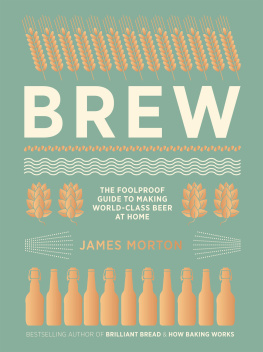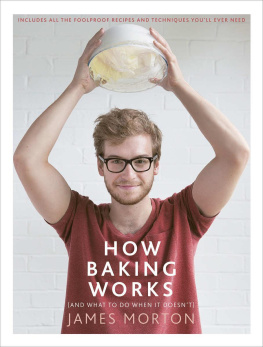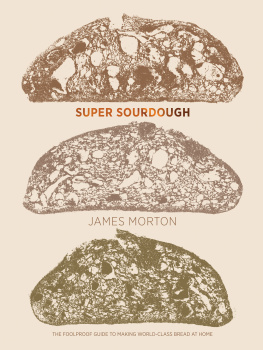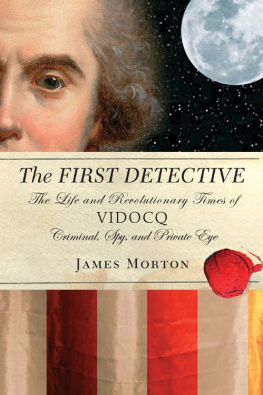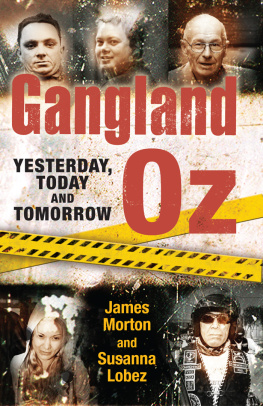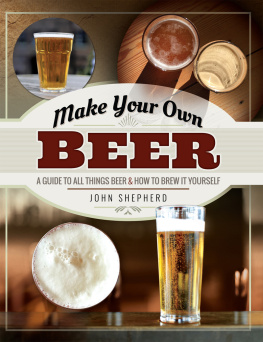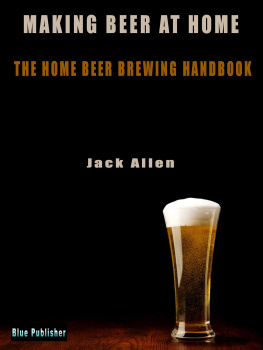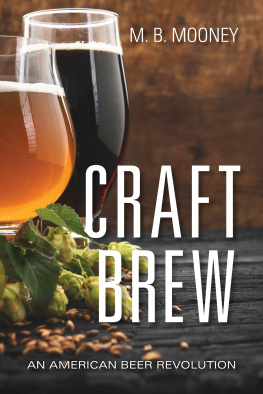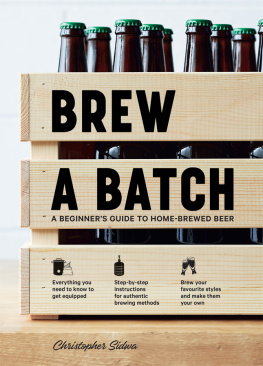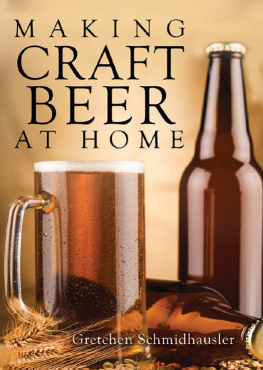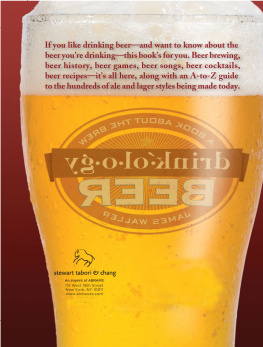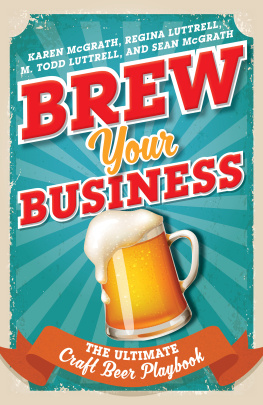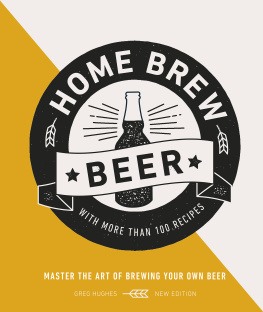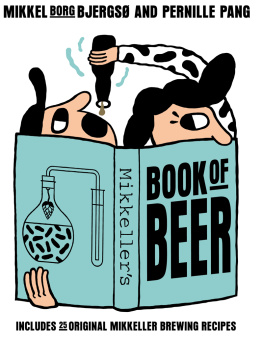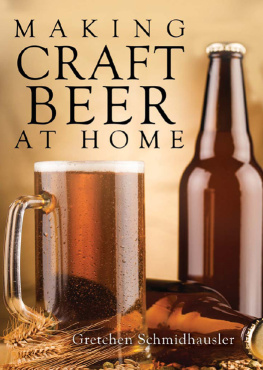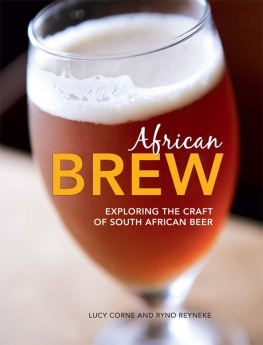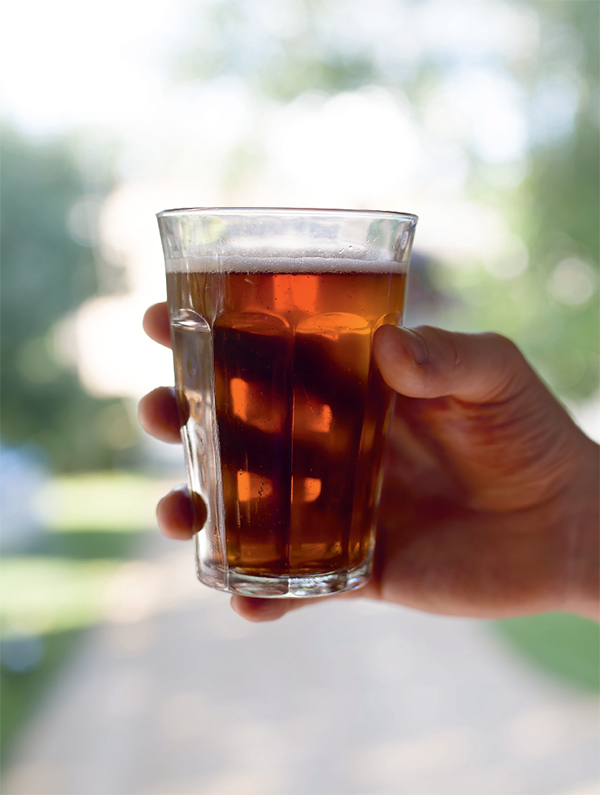CONTENTS
AMERICAN PALE ALE
GOOD BEER IS COMING
Were shunning the stereotypes and were embracing a new way of drinking. Were emptying our cans of carbonated cat-pee down the drain and instead popping open bottles of American craft beer, old Belgians, real British ale and exquisite German lager. Flavour has reached a new level.
This is the beer revolution. Youve probably seen it and perhaps youve been part of it. This book is your next step.
Home brewing has long conjured up visions of old men with beards and dusty corduroys chatting nasally about exploding bottles of infected ale. Now were seeing young people (admittedly, bearded) creating communities around the relative merits of their own bespoke creations, each easily as good as any made on a big scale.
Beer has so much going for it that other alcoholic pretensions do not have. There is little pomposity or snobbery. Beer pairs with food as well as, if not better than, wine. A restaurant is no longer being judged on its wine list, but its tap list.
We cannot appreciate these new flavours to their fullest extent without thinking about how they are born the journey beer goes through before it ends up in the glass you hold in your hand. On making this journey myself I discovered a secret: making good beer at home is easy, and very, very cheap.
This book is designed to take the novice beer enthusiast by the hand as we trek through the worlds of beer and brewing. You dont need to go out and buy loads of stuff. With a plastic bucket or two, you can make great beer from a kit and customise it to your own tastes.
Then, well go through the processes of turning just malted barley, yeast, hops and water into beer better than most. These four components are in nearly every beer in the world. They are cheaply and widely available, in any season, and of outstanding quality. And because such huge variety exists within each of these categories, we can make a huge range of beers, many more combinations than are possible with any other type of alcohol.
Only beer allows you to make your own artisanal alcohol from scratch, anywhere, all year round. Distilling your own gin is illegal, and how many of us have apple trees or grape vines to raid whenever we like? If we want to make wine or cider we have to resort to kits containing juice concentrate. Some of these kits are very good, as they can be for beer as well, but most of the magic is lost. Youre not making something from its component parts.
Im hoping that this wont be like the other books youve seen. Im trying to stray away from the offputtingly technical, textbook style. Im trying to avoid outdated processes that have no evidence base to them, and instead Ill try my best to be friendly, avoid jargon and talk straight from start to finish. Ive made plenty of mistakes in my time, in brewing and otherwise, and I dont mind explaining where I went wrong.
Together, we can bring brewing to life. And make all your friends like you quite a lot more.
Who the hell am I?
My name is James. Im better known in the UK as a baker of bread and all-things-nice. But all the time Ive been writing my first two books, Brilliant Bread and How Baking Works, Ive been brewing. Brewing in my kitchen. The problem is that once you start brewing, your mind wanders on to little else. If someone mentions anything to do with beer, you hijack the conversation. You jump at the chance to have a serious debate about the pros and cons of a particular strain of wild yeast when you sense the presence of a fellow beer geek.
Two things piqued my interest: the potential for cheap beer and the science behind it. The chemistry of the brew day was cool, but it was the manipulation of yeast during the beers fermentation that really made me obsessed. It took me a while to get into it properly as I failed several times to make good beer from beginner kits. I thought about giving up, but I have to thank my good friend Owen for his brewing evangelism and his persistence: he just kept giving me beers that were better than any beer I could buy in any shop. He still does.
Slowly I studied the ingredients and the processes involved in making the styles of beers that I most enjoyed mostly stouts and new-wave American pale ales. I immersed myself in the home brewing community, most of whom were around my age and all of whom were brewing for the same reasons I wanted to: the desire to understand the processes behind their favourite new brews, the pipe dream of urban self-sufficiency and the satisfaction of making a world-class product at home. The hiss when you crack open the first bottle of a perfectly carbonated batch and the warm feeling when you serve up your brews to friends and neighbours, are motivation enough.
My friends, colleagues and fellow Twitterers soon took note of my new preoccupation, and the question When are you going to write a brewing book? became a common one. And once I started thinking about it, that was it. I needed to get the words you are reading onto paper.
I believe I can bring to brewing what I brought to bread. I like to write in simple language that, I hope, makes you feel as if Im sitting across the table from you. Using my experiences of successes and failures in home and commercial brewing, I hope I can do my bit to inspire a young generation of home brewers and beer lovers.
If you think Ive missed anything out or you just want to know more, get in touch on Twitter: @bakingjames.
HOW TO USE THIS BOOK
This book is for those who have never considered brewing and want to understand a bit more about beer. It is for those who have a basic grasp and a few kits under their belt, but want to iron out some flaws. And it is for those with experience who want to continue to grow. It is even for those professionals who feel stuck in their ways and want to explore a new way of doing things. This book is for all of you.
Depending on which of the above categories you fall into, you might think you want to flick through it in a slightly different way. But I implore you to read it as written, from start to finish. We are all learning all the time, and even if you think you know all the basics already, Id love for you to find something you heartily disagree with.
After covering the basics of beer, Im going to go through kit brewing. This is how almost everyone I know started out. Kit brewing (using those tins of sticky syrup and plastic buckets), when done properly, can produce some very good beer indeed. Ill take you through the basic equipment and the basic ingredients youll get in your kit, then take you through what to do to make a good beer every single time. A few modifications, and youll have beer that will blow people away.
Then, well move on to all-grain brews, using just malt, hops, water and yeast. Well go through all the gear you need to make beer of nearly any style and just as good as any brewery in the world, and explain some of the vast variety of ingredients you can choose from. The chapter starting on dedicated to the brew day itself, is the vital one. This you should refer to over and over and over again. No step should be missed. Read the description of each step carefully and feel that you understand exactly what youre doing. If not, read it again.
No matter how well you do, we all make mistakes, so I cover all those in my . This is the last section before we hit the recipes, some of which have won competitions at a national level and most of which have been drunk much too fast to make it that far.

